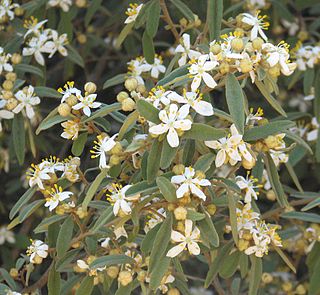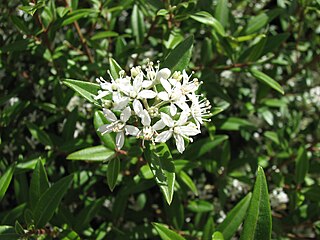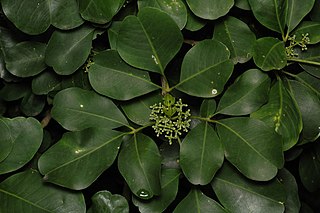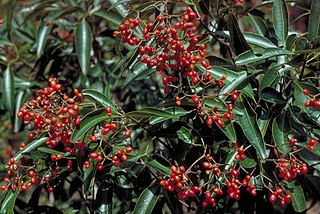
Bosistoa is a genus of four species of tree in the family Rutaceae endemic to eastern Australia. They have simple or compound leaves arranged in opposite pairs and bisexual flowers arranged in panicles, each flower with five sepals, five white petals and ten stamens.

Geijera is a genus of shrubs and trees in the family Rutaceae and are native to New Guinea, Australia and New Caledonia. They have simple leaves arranged alternately, panicles of bisexual flowers usually with five, sometimes four, sepals, petals and stamens and fruit containing shiny black seeds.

Asterolasia is a genus of seventeen species of erect or prostrate shrubs in the family Rutaceae, and is endemic to Australia. The leaves are simple and arranged alternately, the flowers arranged in umbel-like groups on the ends of branchlets or in leaf axils, usually with five sepals, five petals and ten to twenty-five stamens. There are seventeen species and they are found in all Australian mainland states but not in the Northern Territory.

Medicosma is a genus of shrubs and trees in the family Rutaceae, all native to New Guinea, Australia or New Caledonia. They usually have simple leaves arranged in opposite pairs, flowers arranged in cymes with four sepals, four petals and eight stamens. The fruit is a follicle fused at the base in groups of up to four, each containing one or two brown or black seeds.

Phebalium is a genus of thirty species of shrubs or small trees in the family Rutaceae and is endemic to Australia. The leaves are arranged alternately, simple and often warty, the flowers arranged singly or in umbels on the ends of branchlets or in leaf axils, usually with five sepals, five petals and ten stamens. There are about thirty species and they are found in all Australian states but not in the Northern Territory.

Acradenia euodiiformis, commonly known as yellow satinheart or bonewood, is a species of tree that is endemic to eastern Australia. It has mostly trifoliate leaves, the leaflets narrow elliptic to lance-shaped, with prominent oil glands, and panicles of white flowers. It grows in and near rainforest.

Nematolepis is a genus of seven species of plants in the family Rutaceae, all endemic to Australia. They are shrubs or small trees with more or less flat leaves arranged alternately and flowers with five overlapping petals and ten stamens. Six species are found in eastern Australia and one in Western Australia.

Melicope micrococca, commonly known as hairy-leaved doughwood or white euodia, is a species of shrub or slender tree in the family Rutaceae and is endemic to eastern Australia. It has trifoliate leaves and white flowers borne in panicles in leaf axils.

Acradenia frankliniae , commonly known as whitey wood or whity wood, is a species of shrub or small tree that is endemic to Tasmania. It has glandular-warty branchlets, trifoliate leaves with narrow elliptic to lance-shaped leaflets, and panicles of white flowers in leaf axils and on the ends of branclets.
Melicope contermina is a species of shrub or small tree in the family Rutaceae and is endemic to Lord Howe Island. It has trifoliate leaves and white flowers borne in leaf axils in panicles of nine to fifteen flowers.

Melicope polybotrya is a species of shrub or small tree in the family Rutaceae and is endemic to Lord Howe Island. It has trifoliate leaves and green flowers borne in short panicles in leaf axils.

Zanthoxylum ovalifolium, commonly known as thorny yellowwood, oval-leaf yellow wood or little yellowwood, is a species of flowering plant in the family Rutaceae. It is a shrub or tree usually with trifoliate leaves, white, male and female flowers arranged in panicles in leaf axils or on the ends of branchlets and red, purple or brown follicles.

Bouchardatia is a genus of two species of tree in the family Rutaceae, one species endemic to eastern Australia, the other to New Guinea. They have compound leaves with three or five leaflets, and are arranged in opposite pairs. The flowers are bisexual, arranged in panicles, each flower with four sepals, four petals and eight stamens, the petals and stamens all free from each other. The fruit has up to four ridged follicles fused at the base, each containing a single seed.

Dinosperma is a genus of plant containing the single species Dinosperma erythrococcum, commonly known as tingletongue, clubwood or nutmeg, and is endemic to north-eastern Australia. It is a tree usually with trifoliate leaves arranged in opposite pairs, the leaflets lance-shaped to oblong, and panicles of small white flowers, later bright orange to red, slightly fleshy follicles containing shiny, bluish black seeds.
Melicope affinis is a species of shrub or tree in the family Rutaceae and is endemic to Queensland. It has trifoliate leaves and small greenish white flowers borne in panicles in leaf axils.

Melicope broadbentiana, commonly known as false euodia, is a species of shrub or tree in the family Rutaceae and is endemic to Queensland. It has simple leaves, trifoliate leaves or both, and small white flowers borne in short panicles in leaf axils.
Melicope fellii is a species of tree in the family Rutaceae and is endemic to Queensland. It has trifoliate leaves and pink flowers borne in short panicles in leaf axils.
Melicope hayesii, commonly known as small-leaved doughwood, is a species of shrub or slender tree in the family Rutaceae and is endemic to eastern Australia. It has trifoliate leaves and small white flowers borne in panicles in leaf axils.
Melicope littoralis , commonly known as shade tree, is a species of shrub or small tree in the family Rutaceae and is endemic to Norfolk Island. It has trifoliate leaves and small white flowers borne in leaf axils in panicles of a few to many flowers.

Melicope rubra, commonly known as the little evodia, is a species of small tree in the family Rutaceae, and is endemic to north-east Queensland. It has trifoliate leaves and pink bisexual flowers arranged on branches below the leaves.















